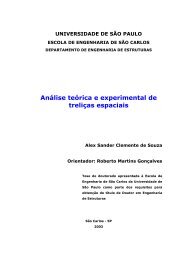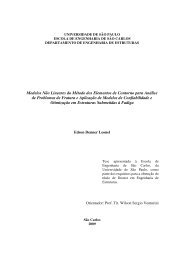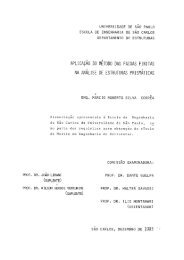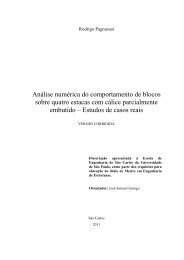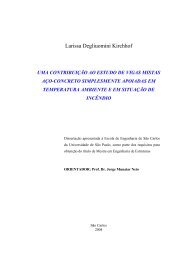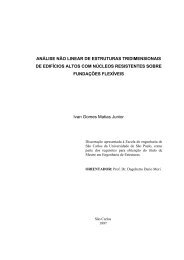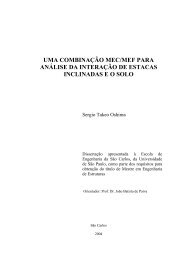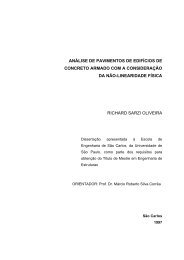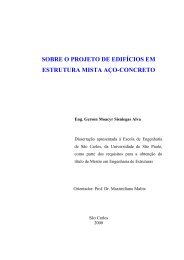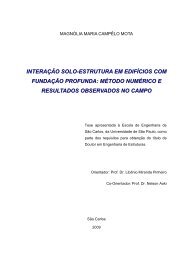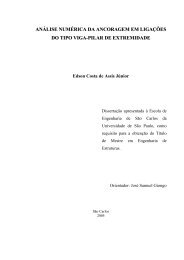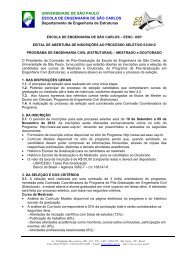Folha de Rosto - Sistemas SET - USP
Folha de Rosto - Sistemas SET - USP
Folha de Rosto - Sistemas SET - USP
Create successful ePaper yourself
Turn your PDF publications into a flip-book with our unique Google optimized e-Paper software.
66 Capítulo 3-Tópicos da Teoria da Elasticida<strong>de</strong> e a Formulação Híbrido-Mista Geral<br />
T −1<br />
∫ ( 1)(<br />
σ )<br />
V<br />
∫<br />
V<br />
∫<br />
Γ<br />
t<br />
P L u − C dV = 0<br />
( )( σ )<br />
P L + b dV = 0<br />
2<br />
( )( σ )<br />
P t − N dΓ<br />
= 0<br />
3<br />
(3.30)<br />
Os vetores P 1 , P 2 e P 3 reúnem as funções-base <strong>de</strong> aproximação empregadas<br />
nas <strong>de</strong>finições das pon<strong>de</strong>rações:<br />
( ) ( ) ( )<br />
p = P δ p p = P δ p p = P δ p<br />
(3.31)<br />
1 1 1 2 2 2 3 3 3<br />
Consi<strong>de</strong>rando a integração por partes da primeira equação <strong>de</strong> (3.30),<br />
aquele conjunto <strong>de</strong> relações resulta:<br />
( ) ( ) σ ( ) ( )<br />
∫ ∫ ∫ ∫<br />
T T T<br />
1 1 1 Γ<br />
1<br />
V V<br />
Γt Γu<br />
T<br />
∫( P2)( Lσ ) dV + ∫(<br />
P2) bdV = 0<br />
V V<br />
T<br />
−∫( P3)( Nσ) dΓ + ∫(<br />
P3) tdΓ<br />
= 0<br />
Γt Γt<br />
LP udV + P F dV − NP u dΓ − NP udΓ<br />
= 0<br />
(3.32)<br />
A formulação dita geral híbrido-mista caracteriza-se por campos<br />
in<strong>de</strong>pen<strong>de</strong>ntes <strong>de</strong> tensão no domínio, <strong>de</strong>slocamento no contorno e <strong>de</strong>slocamento no<br />
domínio. De acordo com esta formulação os campos <strong>de</strong> <strong>de</strong>slocamento no domínio e no<br />
contorno são diferentes, e as tensões e <strong>de</strong>slocamentos no domínio não apresentam<br />
compatibilida<strong>de</strong> entre si. Os mesmos po<strong>de</strong>m ser aproximados conforme o que se segue:<br />
matricial, tem-se:<br />
Γ<br />
u = U q σ = S s u = U q<br />
(3.33)<br />
V<br />
V<br />
u V σ<br />
Γ Γ<br />
Substituindo (3.33) em (3.32) e rearranjando as equações (3.32) em forma<br />
⎡ T T ⎤ ⎧ T ⎫<br />
⎢ ∫( P1) FSVdV ∫( LP1) UVdV −∫( NP1) UΓdΓ ( 1)<br />
t ⎥ NP udΓ<br />
⎧<br />
V V<br />
s ⎫<br />
⎪∫ ⎪<br />
⎢ Γt ⎥ σ Γu<br />
⎪ ⎪<br />
⎪ ⎪<br />
⎢ ⎥⎪ V ⎪ ⎪ T ⎪<br />
⎢ ∫( P2 )( LSV ) dV 0 0 ⎥⎨qu ⎬ = ⎨ −∫(<br />
P2 ) bdV ⎬(3.34)<br />
⎢ V ⎥⎪⎪ ⎪ V ⎪<br />
Γ<br />
⎢ ⎪qu ⎪ ⎪ T ⎪<br />
− ( P3)( NSV) dΓ 0 0 ⎥⎩ ⎭<br />
⎪<br />
− ( P3) tdΓ<br />
⎢ ∫ ⎥ ∫ ⎪<br />
⎣ Γt ⎦ ⎩ Γt<br />
⎭<br />
t u



